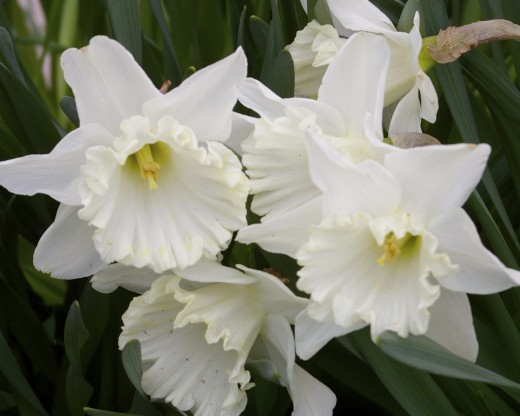Daffodils In Your Garden, Simple, Pure Beauties

Daffodil Days
My lovely daffodils are blooming again, one of the first signs of spring. Aside from the crocuses and flowering trees, daffodils are one of my favorites. Although the proper latin name is Narcissus, I prefer Daffodil. It fits their uncomplicated form and, many varieties are white and yellow, like Donald Duck! I don't know about you, but daffodils and Donald Duck remind me of spring. In my childlike memory, Donald Duck and daffodils announce the arrival of spring.
A hearty bulb that grows beautifully year after year, they are prone to very few problems and sometimes grow a little too vigorously. But, I'll never complain! Do you need to fill a sunny border without worry of whether your choice of flowers willl come back next year? Daffodils may be your answer. Daffodils are inherently healthy and simple in their look and structure They basically have a frilly inner corona and perianths or petals surrounding the corona. The corona can be almost flat to long and trumpet shaped. They are available in thirteen divisions and within these divisions are hundreds of daffodil types. Doubles, hoop in hoop, miniature, two or more colors in the same coronas, some very fragrant, some fragrant free and some with the petals slung back behind them. A windswept daffodil for windy springs. It's all there in that simply shaped, but beguiling flower! That's why I love them. They are available for our gardening delight in beautiful clear yellows, creams and whites and a very light pink. Take your pick between tall daffodils, singles, doubles, or dwarfs.
When they become over crowded, which they will after about three or four years, just dig them up and divide them. Smaller bulbils will develop from the larger, older bulbs. Work the smaller bulbs off gently and replant about four inches deep into the soil. When planting true bulbs such as daffodils and tulips, make the hole four times as deep as the height of the bulb. Place in the ground with the pointed side up. I usually mulch in the spring once I see some shoots. If they are initially planted deep enough, they will be okay without mulch before the shoots emerge.
Daffodils - Where Do They Come From?
Daffodils are originally from Europe, including the Mediterranean areas, and, North Africa. They usually bloom in spring, but some varieties actually bloom in fall or even winter. Daffodil blooms would definitely cheer up a frosty wintry day. They live all over in mountain ranges, woodlands, and, they can grow in silt or, some easily grow in the crevices of rock gardens. Easily adaptable to many environments, these flowers are reliable, beautiful and trouble free. Many public arboretums allow the daffodils to naturalize throughout the less cultivated parts of the gardens which is probably the most natural thing for them to do. Most like dappled shade, but not all. Just do your research on the daffodil you choose and place yours where it will be most happy.
Daffodil Types
Daffodils arrive in bright clear yellows, softer yellows, whites and some very, very, very, light pinks. Their corona (trumpet part of flower) can either be long or very short and the edges are more or less ruffled. The coronas may come in similar colors to the petals or totally contrasting colors. Whatever you choose, you will be aptly rewarded year in and year out. They don't need any special care and can be naturalized into your yard. Just one word of warning, if you are a neatnik, these flowers may not be for you. You must let the leaves alone after the flowers stop blooming. Let them go to the point of brown. Do not cut the leaves off after the flowers die. These leaves provide essential nutrition to the flower so they can bloom beautifully next year.
Some of the wild daffodils are reflexed back, some have a bunch of flowers to a stem, some have just a few or one flower per stem. Some are short and some are quite tall. Some have grass like leaves and some have the regular sword like leaves you would expect .A beautiful petite one is 'Petrel' which is all white including the trumpet, with the edge of the trumpet smooth rather than ruffled. I think this gives the flower an elegant look. Less than a foot high high, a mass of these white flowers would accent whatever other flowers are in your border, but don't put it in the very front or you'll have to contend with the die-back of the leaves. Try some day lilies in front of these daffodils or some lovely grey green artemisia which will be in full regalia when the leaves of the daffodils are dying back. You will have continuous color and texture, and, the line between what is dying back and what is growing will be hidden.
The narcissus variety called 'Rip Van Winkle' is a wonderful daffodil, almost the punk rock flower of the different daffodil groups. It is an extremely double daffodil with narrow petals of varying lengths and lighter and darker shades of yellow. I love this flower, it is such an upstart. There are so many petals that the corona is not even visible! It kind of reminds me of an overgrown dandelion. It is only eight inches tall, but is hardy from zones 4 through 9. This is a Division 4 (double) daffodil.
Narcissus 'Passionale' is truly lovely. Tall, at twenty inches, hardy from zones 4 through 9, this is a unique edition to any garden. I really enjoy that the texture of the petals are like crepe paper and the corona is a lovely dusty pink. This is a Division 2 daffodil which means it is a large cupped daffodil. Keep in mind the height of different daffodils, since this one is twenty inches tall, it could fit comfortably in front of some Phlox Paniculata and behind some shrub roses such as the 'Fairy".
Narcissus 'Cheerfulness' is a stunning flower. It is a regal beauty at sixteen inches tall and has between two to four full, spicy, scented double blooms per stem. The thing that is interesting about this flower is that the corona is double, not the petals. This is really unusual in the daffodils. In the doubles, many times the coronas are hidden. In 'Cheerfulness', the crown is the center of attention and does not get lost in double petals The corona is medium length with overlapping sections that look like a confection of cream and yellow. It is a modified trumpet that is lightly way at the edges. This daffodil likes warm to very warm sun. it originally hails from western and central Mediterranean areas. It is basically a daffodil that likes to stay warm and dry and loves rocky areas. Keep this in mind when you plant this beauty. Zones 5 through 9, Division 4.
Daffodils in Your Garden Design
Many people overlook daffodils, thinking they are ordinary. Look a little closer. These are invaluable flowers for your garden. Look around your neighborhood, you will be surprised by what you might find.
Daffodil Books
- Signup For HubPages
Write about what you are passionate about and get paid for it. Just follow the link to sign up for hubpages, it's completely free.
- Ornamental Grasses - WebAnswers.com
Ornamental Grasses - I love the look of the ornamental grasses as they get older. Are they deer and heat resistant? For the Ornamental Grass Fans, read this bit of infor for Ornamental Grasses




